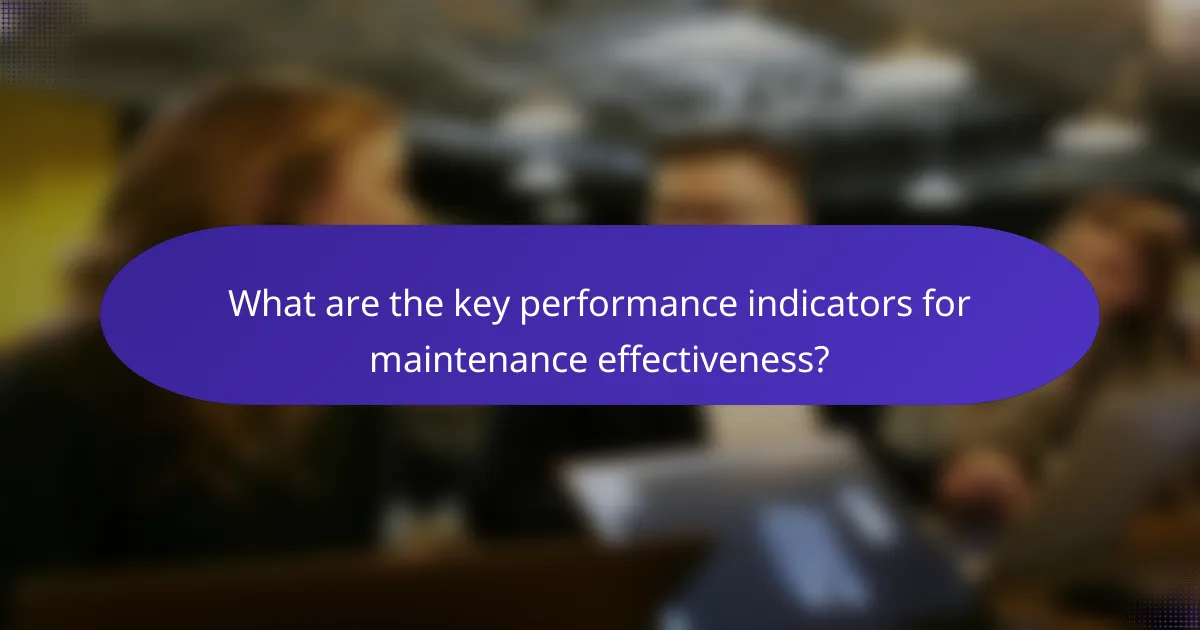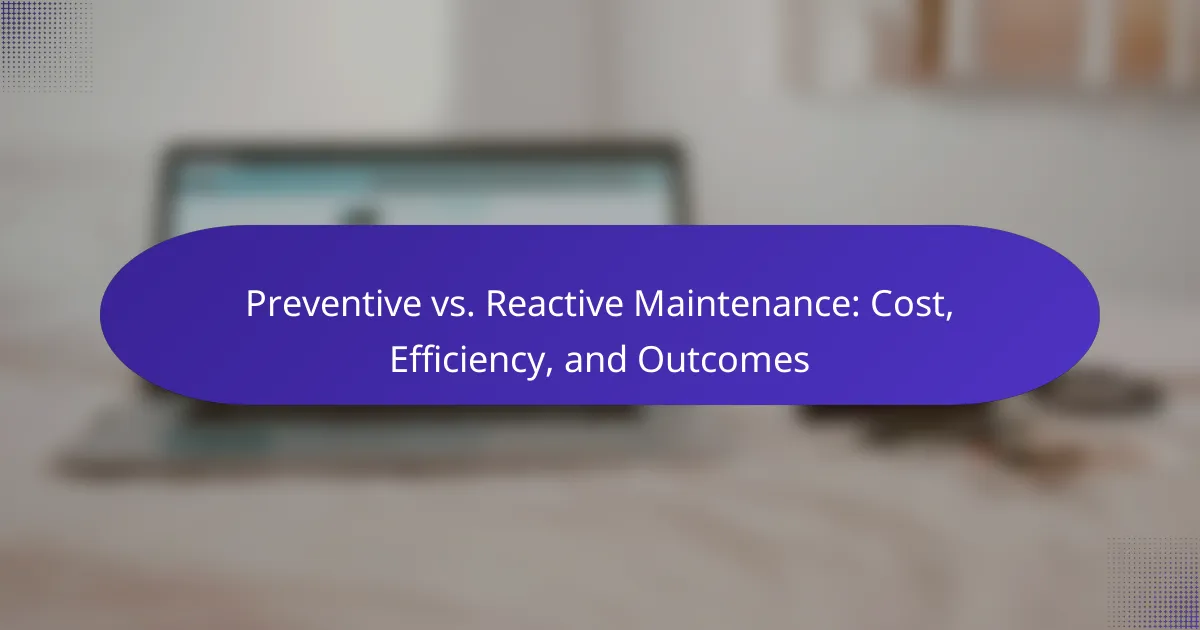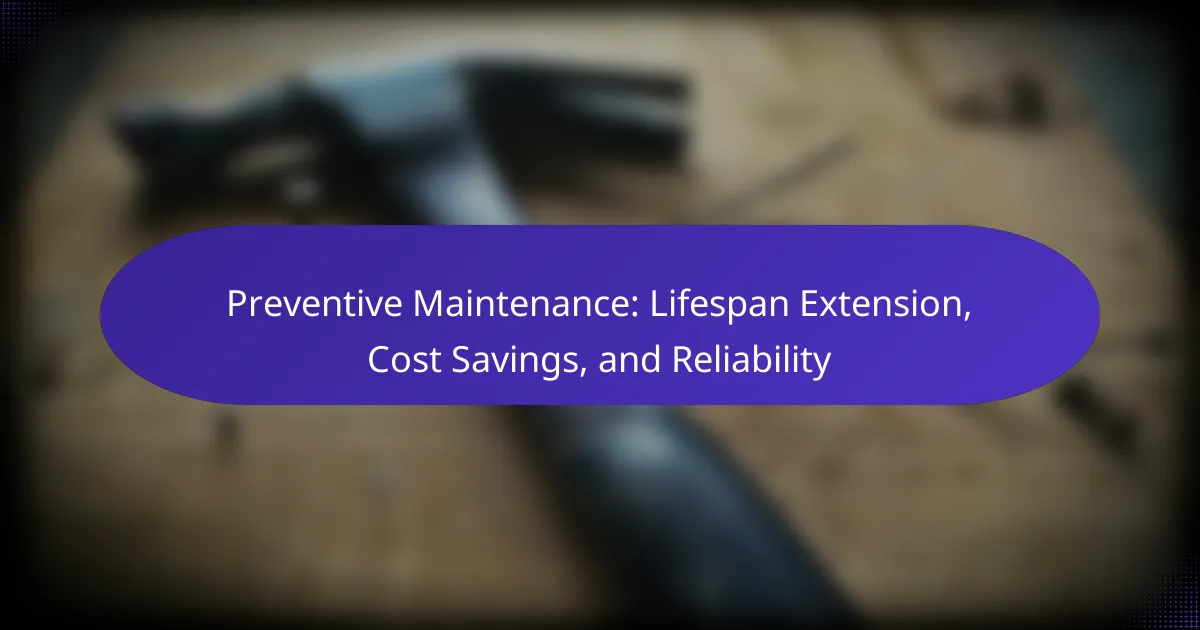Key performance indicators (KPIs) for maintenance effectiveness are essential metrics that enable organizations to evaluate the success of their maintenance strategies. By analyzing indicators such as equipment uptime, maintenance costs, and response times, businesses can gain valuable insights into their operational reliability and efficiency. Additionally, benchmarks like Overall Equipment Effectiveness (OEE) and Mean Time Between Failures (MTBF) help identify areas for improvement and enhance overall maintenance performance.

What are the key performance indicators for maintenance effectiveness?
Key performance indicators (KPIs) for maintenance effectiveness are metrics that help organizations assess how well their maintenance strategies are performing. These indicators provide insights into equipment reliability, maintenance efficiency, and overall operational performance.
Overall Equipment Effectiveness (OEE)
Overall Equipment Effectiveness (OEE) measures the efficiency of a manufacturing process by evaluating availability, performance, and quality. It is calculated by multiplying the three factors: OEE = Availability x Performance x Quality. A high OEE score, typically above 85%, indicates that a manufacturing process is functioning at optimal levels.
To improve OEE, focus on reducing downtime, optimizing production speed, and minimizing defects. Regularly analyzing OEE can help identify areas for improvement and drive better maintenance practices.
Mean Time Between Failures (MTBF)
Mean Time Between Failures (MTBF) is a reliability metric that indicates the average time elapsed between equipment failures. It is calculated by dividing the total operational time by the number of failures during that period. A higher MTBF signifies better reliability and fewer interruptions in operations.
To enhance MTBF, ensure regular preventive maintenance and invest in quality components. Monitoring MTBF trends can help pinpoint weaknesses in equipment and inform maintenance schedules.
Mean Time to Repair (MTTR)
Mean Time to Repair (MTTR) measures the average time taken to repair equipment after a failure occurs. It includes the time spent diagnosing the issue and completing the repair. A lower MTTR indicates a more efficient maintenance process and quicker recovery from failures.
To reduce MTTR, maintain an organized inventory of spare parts and provide adequate training for maintenance staff. Implementing standardized repair procedures can also streamline the repair process and minimize downtime.
Maintenance Cost as a Percentage of Replacement Asset Value
This KPI assesses maintenance costs relative to the total replacement asset value (RAV) of equipment. It is calculated by dividing total maintenance costs by the RAV and multiplying by 100 to get a percentage. A lower percentage indicates more cost-effective maintenance practices.
To manage maintenance costs effectively, consider implementing predictive maintenance strategies that can reduce unexpected expenses. Regularly review and adjust maintenance budgets based on asset performance and condition.
Planned vs. Unplanned Maintenance Ratio
The Planned vs. Unplanned Maintenance Ratio compares the amount of scheduled maintenance to reactive maintenance. A higher ratio of planned maintenance indicates better management of maintenance activities and often leads to reduced downtime and costs.
To improve this ratio, develop a comprehensive maintenance schedule and prioritize preventive measures. Tracking this KPI can help organizations identify trends and adjust their maintenance strategies accordingly.

How to measure maintenance effectiveness?
Measuring maintenance effectiveness involves evaluating how well maintenance activities contribute to operational reliability and efficiency. Key indicators include equipment uptime, maintenance costs, and response times, which provide insights into overall performance.
Data Collection Methods
Effective measurement of maintenance effectiveness starts with robust data collection methods. Common approaches include manual logging, automated sensors, and maintenance management systems that capture real-time data on equipment performance and maintenance activities.
Utilizing a combination of these methods can enhance accuracy. For instance, automated systems can provide continuous monitoring, while manual logs can capture qualitative insights that machines may miss.
Utilizing Maintenance Management Software
Maintenance management software (MMS) streamlines data collection and analysis, making it easier to track maintenance effectiveness. These platforms often include features for scheduling, work order management, and reporting, which help in organizing maintenance tasks efficiently.
When selecting an MMS, consider factors such as user-friendliness, integration capabilities with existing systems, and scalability to accommodate future growth. Popular options include CMMS (Computerized Maintenance Management Systems) that can significantly reduce administrative burdens.
Key Metrics Tracking
Tracking key metrics is essential for assessing maintenance effectiveness. Important metrics include Mean Time Between Failures (MTBF), Mean Time to Repair (MTTR), and maintenance cost as a percentage of asset value. These indicators help identify trends and areas for improvement.
For practical tracking, establish benchmarks based on industry standards or historical data from your own operations. Regularly reviewing these metrics can inform strategic decisions and optimize maintenance processes, ultimately leading to improved operational efficiency.

What benchmarks should be used for maintenance effectiveness?
Benchmarks for maintenance effectiveness typically include metrics such as Overall Equipment Effectiveness (OEE), Mean Time Between Failures (MTBF), and Mean Time to Repair (MTTR). These indicators provide a clear view of maintenance performance and help organizations identify areas for improvement.
Industry Standards for OEE
Overall Equipment Effectiveness (OEE) is a widely recognized benchmark that measures the efficiency of manufacturing processes. It combines three factors: availability, performance, and quality. A strong OEE score is generally considered to be above 85%, indicating that equipment is running effectively with minimal downtime.
To calculate OEE, multiply the availability rate by the performance rate and the quality rate. For example, if a machine operates at 90% availability, 95% performance, and 98% quality, the OEE would be approximately 84.3%. Regularly tracking OEE can highlight inefficiencies and guide maintenance strategies.
Benchmarking MTBF and MTTR
Mean Time Between Failures (MTBF) and Mean Time to Repair (MTTR) are critical metrics for assessing maintenance effectiveness. MTBF indicates the average time between equipment failures, while MTTR measures the average time taken to repair equipment after a failure. High MTBF values suggest reliable equipment, while low MTTR values indicate efficient repair processes.
For many industries, an MTBF of several hundred to a few thousand hours is typical, while MTTR can range from single-digit minutes to a few hours, depending on the complexity of the machinery. Organizations should aim to increase MTBF and reduce MTTR through proactive maintenance and effective training of maintenance staff.
Comparative Analysis with Industry Peers
Conducting a comparative analysis with industry peers can provide valuable insights into maintenance effectiveness. By benchmarking your OEE, MTBF, and MTTR against similar organizations, you can identify performance gaps and best practices. This analysis can be facilitated through industry reports or maintenance management software that aggregates data across companies.
When comparing metrics, consider factors such as equipment type, operational environment, and maintenance strategies. Engaging in industry forums or networks can also provide opportunities to share experiences and learn from others’ successes and challenges. This collaborative approach can lead to improved maintenance practices and overall performance.

How to report on maintenance effectiveness?
Reporting on maintenance effectiveness involves tracking and analyzing key performance indicators (KPIs) to assess how well maintenance activities support operational goals. Effective reporting provides insights into areas for improvement, helping organizations optimize their maintenance strategies.
Creating Maintenance Dashboards
Maintenance dashboards visually present key metrics, allowing for quick assessment of performance. They should include KPIs such as equipment uptime, mean time to repair (MTTR), and maintenance costs, enabling stakeholders to monitor trends over time.
When designing dashboards, prioritize clarity and relevance. Use graphs and charts to highlight critical data points, and ensure that the layout is intuitive. Regular updates are essential to keep the information current and actionable.
Utilizing Key Performance Reports
Key performance reports compile data from maintenance activities and provide detailed analysis over specific periods. These reports should include comparisons against benchmarks, such as industry standards or historical performance, to gauge effectiveness.
Consider including sections on root cause analysis and recommendations for improvement. This approach not only highlights successes but also identifies areas needing attention, ensuring that maintenance practices evolve to meet operational demands.
Communicating Results to Stakeholders
Effective communication of maintenance results to stakeholders is crucial for transparency and decision-making. Tailor the message to the audience, focusing on how maintenance performance impacts overall business objectives.
Use concise summaries and visual aids to convey complex data clearly. Regular meetings or reports can facilitate discussions about performance trends and necessary adjustments, fostering a collaborative environment for continuous improvement.

What are the best practices for improving maintenance effectiveness?
Improving maintenance effectiveness involves adopting strategies that enhance reliability and reduce downtime. Key practices include implementing predictive maintenance, providing regular training for staff, and leveraging IoT technology for real-time monitoring.
Implementing Predictive Maintenance
Predictive maintenance focuses on anticipating equipment failures before they occur, allowing for timely interventions. This approach typically uses data analysis and monitoring tools to assess the condition of machinery and predict when maintenance should be performed.
To implement predictive maintenance effectively, organizations should invest in sensors and data analytics software. Regularly reviewing equipment performance data can help identify patterns and potential issues, leading to maintenance actions that are more informed and less reactive.
Regular Training for Maintenance Staff
Regular training for maintenance staff is crucial for ensuring that they are equipped with the latest skills and knowledge. Continuous education helps technicians stay updated on new technologies, best practices, and safety protocols.
Consider scheduling training sessions at least quarterly and incorporating hands-on workshops. This not only enhances staff competency but also fosters a culture of safety and efficiency within the maintenance team.
Leveraging IoT for Real-Time Monitoring
Leveraging IoT technology enables real-time monitoring of equipment, providing valuable insights into operational performance. IoT devices can collect data on various parameters, such as temperature, vibration, and usage patterns, which can be analyzed to detect anomalies.
To maximize the benefits of IoT, ensure that your systems are integrated and capable of communicating effectively. This integration allows for immediate alerts when issues arise, facilitating prompt maintenance actions that can prevent costly downtimes.
![]()
What tools are available for tracking maintenance KPIs?
Several tools are essential for tracking maintenance KPIs effectively, including software solutions, spreadsheets, and dashboards. These tools help organizations monitor performance, identify areas for improvement, and ensure compliance with industry standards.
CMMS Software Solutions
Computerized Maintenance Management Systems (CMMS) are specialized software designed to streamline maintenance operations. They enable organizations to track assets, schedule maintenance tasks, and analyze performance metrics in real-time.
When selecting a CMMS, consider factors such as ease of use, integration capabilities, and cost. Many solutions offer features like mobile access, reporting tools, and customizable dashboards, which can enhance maintenance effectiveness.
Popular CMMS options include Maintenance Connection, Fiix, and Hippo CMMS. These platforms typically offer subscription pricing, ranging from low tens to several hundred dollars per month, depending on the number of users and features required.



